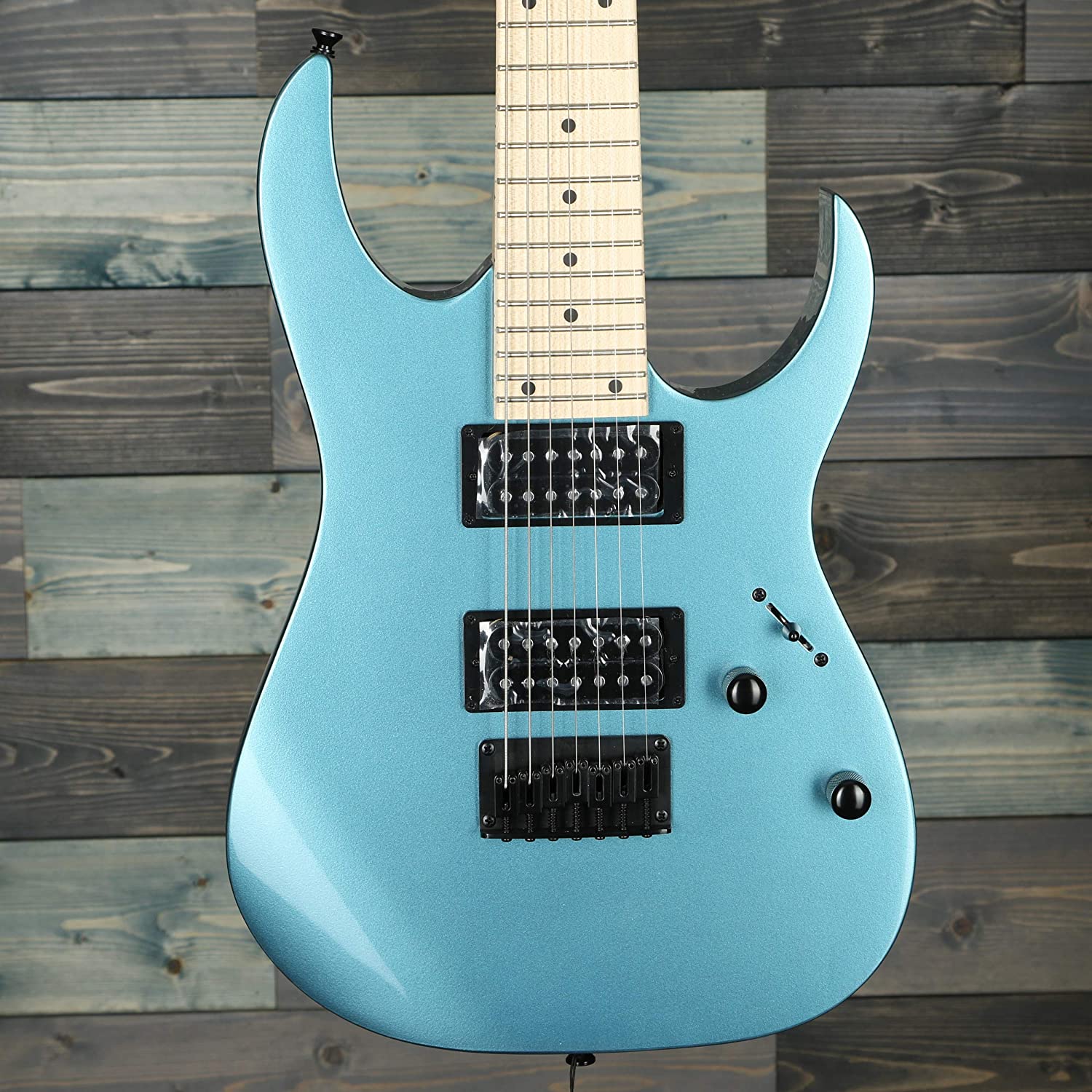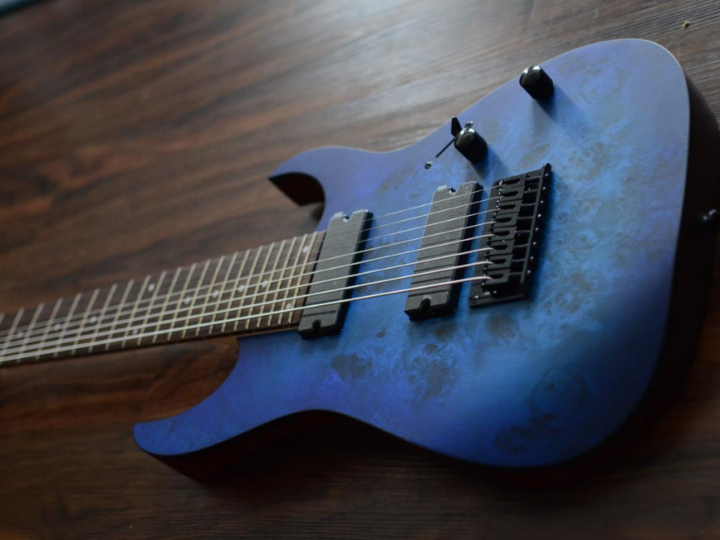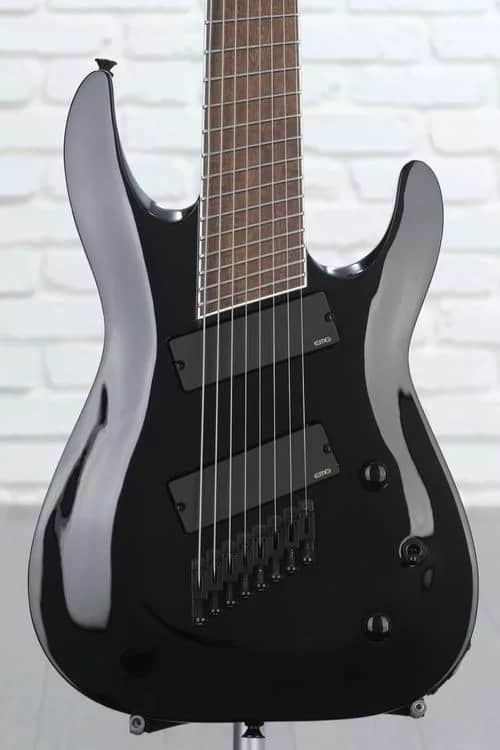Owning an 8-string guitar opens a new world of heavy tones and tunings. The signature chugs and low tuning of extreme metal music are not meant to be played on a 6-string guitar, and a 7-string might go low enough. With the newly added range comes a new concept of fretboard and tuning. This 8-string tuning guide covers not only different 8 string guitar tuning but also how to get a tight tone when going low.
My bottom line up-front; 8-string guitars offer an exceptional tonal range and the possibility of using many alternate tunings. As with all instruments, there is a learning curve and much work to start playing as freely as you would on a standard guitar.
The best way to adapt quickly to new tunings or create your own is to study some music theory and get a good grasp of intervals. Also, remember that getting a good tone becomes a challenge the lower you tune your guitar.

8 String Guitar Standard Tuning
The 8-string guitar standard tuning is F# – B – E – A – D – G – B – E. The logic of this tuning is a continuation of the 6 and 7-string guitar tuning where the guitar is tuned in 4th. The only difference is that the lower string is not a G (4th of the B) but an F# (5th) to make playing chords easier.
The advantage of this tuning is that you can play power chords on the top string like on a 6- string guitar. The same shape applies, and you can move from the 8th to 7th or 6th string holding a power chord, and it will work. Most of the playing on the 8-string is focused on the lower strings, so it’s crucial to have a familiar feel on them.
Another advantage is playing common full chords and following most standard tuned music. You are less likely to play rock with an 8-string, but tuning in standard helps when you play with people who don’t have an instrument specific to metal. For example, if you are playing with another bandmate that plays a 6-string guitar or 4-string bass.
You get a down-tuned standard guitar if you lower all the strings by an equal interval, for example, half step. A widespread one made popular by the band Meshuggah is F Standard, where all the strings are half step down. The string would be F – Bb – Eb – Ab – Db – Gb – Bb – Eb.
A very common tuning is A standard tuning where strings are A – D – G – C – F – A – D – G. This tuning is very low, three and a half steps beyond F#. A handful of bands use this, and it sounds visceral and heavy with the right metal tone settings.
You can go as low as the guitar handles it and still name it after the note of the 8th string – ‘standard.’
8 String Guitar Drop Tunings
Drop tuning is very common for 8-string guitars. The tuning is called dropped when you lower only the guitar’s 8th string.
In standard tuning, the pitch of the 8th string should match the 6th string. The Tuning is called Drop E, and the strings are tuned E – B – E – A – D – G – B – E. If your guitar is tuned to F standard, then all the notes would be half step lower, meaning Eb – Bb – Eb – Ab – Db – Gb – Bb – Eb.
Tosin Abasi is one of the most famous 8-string guitarists to use the Drop E tuning. His music is what I would suggest you listen to first as an example of how versatile an 8-string guitar can be.
There are many advantages to drop tunings. They extend the range of the guitar and inspire you to play differently. Another advantage is the freedom to play open low strings and get a power chord. Beyond being fun, open strings give a new sound to the guitar with natural harmonics ringing freely.
I have been obsessed with drop tuning for a good part of my playing career, and as much as I like them, they come with a risk. If you use the open strings too much, your riffs start sounding very similar, and you lose some playing dynamics. Droning over the 8th string tonality for long is fun for the player but not as much for the listener.

8 String Guitar Alternate Tunings
The best thing about an 8-stringed guitar and its specific function is how experimental you can get with tunings. Not having the pressure of playing ‘standard’ songs means you can approach guitar differently if you wish and create a unique style.
An open tuning is when the guitar is tuned to a chord. Devin Towsend uses an open C tuning where the individual strings are tuned to E – C – G – C – G – C – G – E. The main advantage is that the open string will sound like a C major and inspire you to write and play differently.
You can tune the 8-string guitar to every open chord you wish if you find a good balance between intonation and attack. Remember that not all 8-string guitars can keep intonation when tuned very low, especially cheap ones.
Some knowledge on how to build chords and music theory can be helpful too. If you know the formula of a chord, then you can tune your string to that and add the proper chord extensions. I won’t be covering much theory in this article, but a good starting point is to learn what intervals are and how they work on guitar.
Why Would You Need an 8 String Guitar?
The primary purpose of an 8-string guitar is getting the extra range commonly needed in modern metal. The main metal subgenres that use an 8-string guitar are Metalcore, Nu Metal, Atl Metal, and Djent. You can also experiment and use the extra range on many types of fingerstyle guitar music, jazz, and different kinds of prog music.
The limit is your imagination. However, it’s not a guitar you can easily improvise with and limits your playing of some genres. If you’re still considering if you need to buy an 8-string or not, here are some pros and cons of it.
8 String Guitar Pros
- It has an incredible range.
- You can play heavy metal subgenres, especially modern extreme metal, djent, etc.
- Handles all possible down tunings without having intonation issues.
8 String Guitar Cons
- The longer scale length and thick fretboard make it harder to play
- Soloing and bending are harder than one a 6 or 7 string guitar
- It limits your ability to play many genres other than metal
- It’s hard to keep the sound tight
How Low Can You Go On an 8 String?
There’s a limit to how you can tune an 8-string guitar. Theoretically, you can tune your 8-string guitar very low, to the limit of what the human ear can. In practice, the string gets too loose, and you can’t get a defined sound the lower you go.
Lower than the drop E tuning playing chords io
How to Keep the Sound Tight on Low Tunings?
When tuning the strings very low, there’s the risk of losing no definition and attack. What commonly happens with new 8-string guitar players is that they crank up the gain as they would on a normal guitar and slightly lower the bass to avoid getting muddy. This, however, does not always work as the lowers you go, the harder it is to get a tight tone.
What you want to avoid is not only the bummy low end; the goal is to keep the tone percussive and with enough attack to support the groove. I use multiple tricks in the studio to fix that; most can be done with little engineering knowledge and the standard pedals and high gain amps.
- Don’t use too much gain.
The temptation to use a lot of gains is high, yet the more you use it beyond a point, the more it ‘numbs’ the tone. When used on a mix, producers usually bring down the gain on guitar to keep them crunchy and aggressive.
The trick to learning how to use gain is to listen to isolated guitar tracks from famous songs.
- Use a compression pedal or distortion/overdrive in front of the amp.
A good pedal in front of the amp functions great as a tool to tighten the guitar’s tone. Put the drive and gain almost to 0 and play with the tone and volume knob until you get the right sound. Not all distortion and compression pedals work; some might even make the sound worst.
8 String Guitar Recommendations
There are many choices for the best 8 string guitar out there. Some that I like from every price range are the following.
Ibanez Prestige RG5328
The Ibanez Prestige RG5328 s one of the best 8-string guitars for seasoned metal guitarists. As with all Prestige series instruments, it’s built with the finest parts from word-class luthiers.
The best quality of the guitar, apart from the playability, is the DiMarzio Fusion Edge 8 humbucking pickups. The guitar has a great tonal range, from brutal heavy and dark to crisp clean. This makes great for both rhythm and leads and more genres than metal.
The RG5328 is an expensive instrument, yet there are far more costly signature models that offer almost the same quality. If you are using the guitar only playing a specific role, spending more than 2000$ on it might not bring much to your overall sound.
It’s an investment, but it’s ready to play on any stage and studio.
The Ibanez Prestige RG5328 8-string electric is a metal and rock player's dream. The all-ash body of the RG5328 is resonant, lightweight, and, with a beautiful satin finish, stunning to look at.
Schecter Omen-8, 8-String Electric Guitar
An affordable 8-string guitar like the Schecter Omen-8 is perfect for
Even though it does not compare to the quality pickups and tonewoods of a premium Ibanez, you can still get all the down tuning heavy sound for your riffs. The pickups are very hot and warm, ideal for extreme metal. The downside of the pickups is that they are not very articulated, and you need to be very careful when tuning very low.
The guitar’s intonation is good, yet it can cause very slight tuning issues when the strings become loose from down tuning. Overall the playability is good for riffs but not as good if you want to lead on it.
If you want to try your hands with an 8-string to see if it suits you, this guitar could be a great starting point.
The Omen-8 easily outperforms just about any 8-string in its class. A pair of ultra-hot Schecter Diamond Plus pickups let you easily push any real amp into overdrive Nirvana, and a great collection of tonewoods provides a solid foundation for extremely aggressive tone.
Jackson X Series Soloist Arch Top SLAT8 Multi-Scale – Gloss Black
In between the affordable and premium 8-string guitar is the Jackson X Series Soloist Ach Top SLKAT 8 Multi-Scale. I recommend this for every advanced guitarist who occasionally uses an 8-string guitar or for advancing players that need a good guitar for live shows.
The main advantage of this guitar is the Multi-Scale neck. The scale length is longer on the bass side and shorter on the treble side. This allows for perfect intonated notes up and down the neck when tuning low.
The guitar’s tone is tight, but it can become muddy fast if you don’t know how to adjust it. The active humbuckers tend to side ‘bummy’ with the wrong amp settings. They are still quality pickups that will help you achieve a groovy tone.
If you play both extremely low down-tuned riffs and lead up the neck, this guitar is a great 8-string choice.
The Jackson X Series Soloist Archtop SLAT8 FF 8-string electric guitar is built for high-speed, down-tuned playing, by virtue of its multi-scale 26-28-inch scale length.
8 String Guitar Tuning FAQs
Question: Who plays an 8 string guitar?
Answer: Some famous players are; Tosin Abasi, Fredrik Thordendal of Meshugahh, Simon Girard of Beyond Creation, Greg Burgess of Allegaeon, Stephen Carpenter of Deftones.
Question: When was the 8 string guitar invented?
Answer: Many traditional guitar-like instruments had 8 strings, yet the modern 8-string guitar was first released in 1994 by Paul Galbraith and luthier David Rubio. The first metal band to popularize the instrument was Meshuggah with their album NOTHING.’
Question: Should I start with an 8 string guitar?
Answer: I recommend starting with a 6-string and then going to a 7 or 8 string. Learning guitar on an 8-string is challenging due to the extra string and longer scale length. if you truly want to or no other option is available, you can start learning guitar with an 8-string
Final Thoughts on 8 String Guitars Tuning
The many tuning possibilities are why I would choose to buy an 8-string guitar beyond the unique range it offers. What is essential is not just memorizing tunings but also learning why they work and how you can create your own.
First, take your time with standard tuning, then gradually start going from dropped to alternate open tunings. Feel free to improvise and try some new ‘weird’ tuning, as it could inspire you to create something unique.
- Do you Actually Need a Trembucker? Humbucker vs Trembucker - May 11, 2024
- Best Headphones for Guitar Amp Guide - April 23, 2024
- Takamine vs Martin Comparison – US-Made Legacy Against Japanese Precision - March 30, 2024







